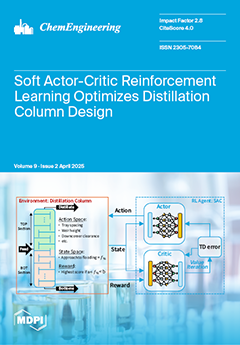This study aimed at preparing three types of biochar derived from rice husk via pyrolysis, including unactivated biochar, biochar chemically activated after with H
3PO
4, and biochar impregnated with γ-Fe
2O
3 nanoparticles. These materials were subsequently characterized using
[...] Read more.
This study aimed at preparing three types of biochar derived from rice husk via pyrolysis, including unactivated biochar, biochar chemically activated after with H
3PO
4, and biochar impregnated with γ-Fe
2O
3 nanoparticles. These materials were subsequently characterized using Scanning Electron Microscopy (SEM), Fourier Transform Infrared Spectroscopy (FTIR), and Brunauer–Emmett–Teller (BET) analysis, which revealed favorable textural properties, such as an increased surface area and porosity, as well as the presence of functional groups that facilitate the adsorption of methylene blue and malachite green in aqueous solutions. Several factors that affect the adsorption capacity, including the type of material, pH effect, and adsorbent dosage, were evaluated and optimized. The adsorption behavior was analyzed using isotherm and kinetic models to better understand the mechanisms involved. Under optimal conditions, biochar@γ-Fe
2O
3 NPs emerged as the most effective material due to its high surface area, functionalized surface, and magnetic properties, allowing easy water recovery without the need for complex instrumentation. Among the kinetic models evaluated, the pseudo-second-order model exhibited the highest linear regression coefficient (R
2 = 0.99), supporting a chemisorption process driven by strong interactions and stable chemical bond formation between the adsorbate and the adsorbent, while equilibrium data fit well with the Sips isotherm model, indicating a combination of monolayer and multilayer adsorption mechanisms. This magnetic biochar achieved removal efficiencies of 97% for methylene blue and 95% for malachite green, demonstrating a high performance and reusability over four cycles. Moreover, a possible adsorption mechanism of MB on the magnetic biochar was proposed to explain the interaction between the dye and the adsorbent surface. Thus, this work demonstrates that magnetic biochar is a sustainable and cost-effective adsorbent for wastewater treatment, integrating circular economy principles by transforming rice husk into a high-value material. The incorporation of γ-Fe
2O
3 nanoparticles enhances adsorption while enabling magnetic recovery, providing an eco-friendly and scalable solution for dye removal.
Full article





